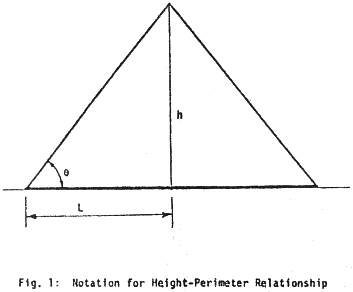
Stuart W. Greenwood, “Some reflections on pyramid slope angles”
Pursuit, July 1975, pp. 72–76.
Pursuit was the journal of the Society for the Investigation of the Unexplained (SITU), founded by Ivan T. Sanderson (1911–1973). It ceased publication in the 1990s.
View remarks by Bob Schadewald
The large stone pyramids of Egypt have long held a fascination for anthropologists, and for mankind as a whole. It is recognized that they functioned as impressive memorials for Egyptian kings, but why were they built the way they were?
| Pyramid Group |
Latitude °N |
Pyramid | Measured Slope (Ref. 1) |
Comparison h/L (Ref. 4) |
| — | 29° 23′ | Meydum | 51° 53′ | 4/π or 14/11 |
| Dashur | 29° 41′ | Southern (“Bent”) |
43° 21′ 54° 31′ |
17/18 7/5 |
| Northern | 43° 40′ | (3/π) | ||
| Giza | 29° 59′ | Cheops (Great Pyramid) |
51° 50′ | 4/π or 14/11 |
| Chephren | 53° 10′ | 4/3 | ||
| Mycerinus | 51° 50′ | — |
The main pyramids are listed in Table 1. The base alignments lie close to the N-S, W-E directions, the alignments being within a few minutes of arc in the case of the Great Pyramid. These alignments are clearly astronomical in character, and have led to the suggestion that changes in the base directions of the Great Pyramid since it was constructed may provide data on geologic changes such as continental drift (Ref. 2). Such studies have not yet proved fruitful.

The question of the choice of pyramid slope angles has long intrigued anthropologists. Fakhry (Ref. 1) considers that the choice of angle was probably made on structural grounds. Mendelssohn (Ref. 3) has recently presented a persuasive argument that the pyramid at Meydum collapsed before it was completed, and led to a decision to alter the slope of the Southern pyramid at Dashur then under construction. The problem remains, however, of why particular angles were selected over any other. We can relate the angle of slope to suitable linear dimensions by simple geometry (Fig. 1). The ratio of the height, h, to one-half of the base dimension, i.e. L, gives the tangent of the slope, θ. In fact Lauer (Ref. 4) suggests that the pyramids were constructed on the principle of a given rise in height for a given distance in from the base, in other words on the basis of a suitable value of h/L. The last column of Table 1 shows the values given by Lauer that agree within 3 minutes (or one-twentieth of a degree) with the measured slopes. The value of 3/π for the Northern Pyramid at Dashur was computed by the present writer to complete the table. The original slope of Mycerinus is not accurately known due to its present state of disrepair.
Mendelssohn quotes a suggestion of Connolly that horizontal distances may have been laid out with a rolling drum. This could be the explanation for the supposed knowledge of the magnitude of π, the ratio of the circumference of a circle to its diameter, by the early Egyptians.
The present writer has been examining the possible astronomical significance of the various slopes, using the mathematical concept that a surface is locally defined by the direction of its normal, i.e., a line drawn perpendicular to it. With reference to Fig. 2, it is seen that if we take a typical slope value of 52° for one of the Giza pyramids at a latitude close to 30° N, a line drawn perpendicular to the Southern face of the pyramid would point in a direction roughly parallel to the Ecliptic (the plane of the motion of the Earth around the Sun) at a time each day when the pyramid was most distant from the Ecliptic. This situation arises because the pyramid slope angle is roughly equal to the sum of two angles, the latitude of Giza and the angle between the Equatorial plane and the Ecliptic. The latter angle is called the Obliquity of the Ecliptic, and is currently about 23½°.
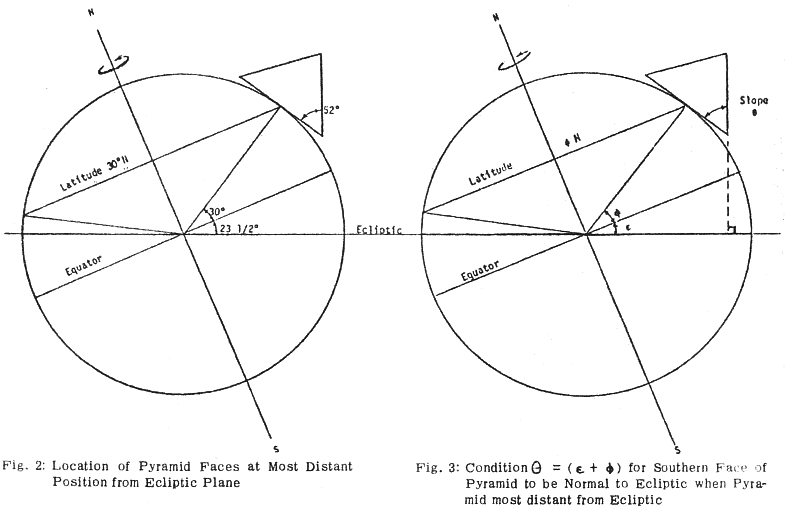
The three pyramids at Giza lie roughly on a line running from NE to SW. As viewed by an observer in the Ecliptic, e.g. on one of the other planets in our Solar system, all of which orbit in planes close to the Ecliptic, it would be possible to observe all these pyramids from different aspects as they rotated with the Earth. Observation would be possible because of the reflected sunlight that is the basis of observational astronomy, and would be facilitated by the polished limestone facings that once covered the Giza pyramids and that, regretfully, has been almost completely removed by irresponsible builders in more recent times. We here pose the question: Were the Giza pyramids intended as signalling devices, using reflected sunlight, to other planets in the Solar System to indicate the presence of artificial structures on Earth, and hence the presence of a corresponding level of technology?
The condition for the Southern face of one of the pyramids to be perpendicular to the Ecliptic when the pyramid is most distant from the Ecliptic is shown in Fig. 3. The condition is shown in its most general form, but only the pyramid at Meydum and the Giza pyramids show any chance of qualifying. If we postulate that the slopes were selected with the requirement shown in Fig. 3 in mind, we are led to seek an explanation for the fact that today the requirements are only approximately satisfied.
In the process we propose to disregard (at our peril, as we shall see) the oft-repeated injunction of Gerald S. Hawkins to the effect that constructional dates should not be determined from astronomical alignments. We will investigate the possibility that changes in the Obliquity of the Ecliptic are responsible for the presently observed discrepancies. It is known that the Obliquity of the Ecliptic is currently decreasing from its present value of about 23½°, and some data on the variation going back well before the dawn of known history is given in Ref. 5.
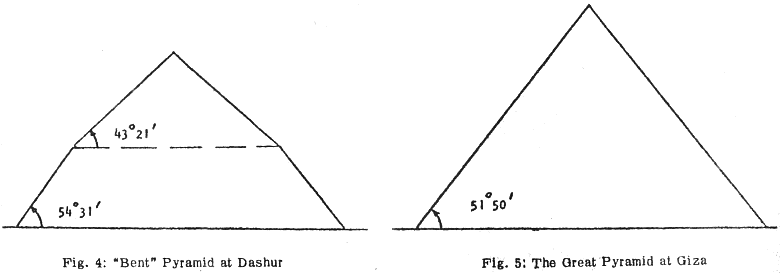
The author deplores the preoccupation shown by many writers with the Great Pyramid, and wishes at this point to reassure the reader that the others are not“not” omitted in published version; added by hand in scanned copy. being passed over. For example, the so-called “Bent” Pyramid at Dashur (Fig. 4), which was built before the Great Pyramid (Fig. 5), will come in for its share of attention in due course. For the moment we return to the pyramids having slopes of around 52°.
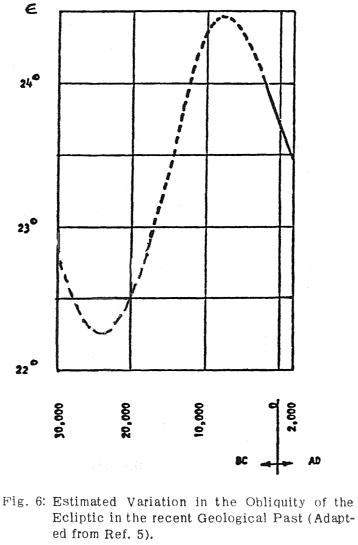
Results from Ref. 5 for the recent geologic past are reproduced in adapted form in Fig. 6. It is seen that, as we go back in time, the Obliquity of the Ecliptic first increases, then reaches a maximum and then decreases. A full presentation of the data would show something like the familiar “sine” curve of trigonometry, with a total range of angle lying between about 22¼°22½° as published; Fig. 6 amended by Dr Greenwood in letter dated 15 January 2013 and 24½°. If we now attempt to satisfy the conditions shown in Fig. 3, we find ourselves in a quandary. The discrepancy considered above becomes worse rather than better as we go back to about 2,500 BC when the pyramids are believed by anthropologists to have been constructed. We have to go back further in time to a period when the Obliquity of the Ecliptic was less that it is now to force the data to fit. The construction dates indicated by such a manoeuver are given in Table 2.
| Pyramid | Slope θ |
Latitude φ |
(θ − φ) | Approx. Construction Date If ε = (θ − φ) |
| Meydum | 51° 53′ | 29° 23′ | 22° 30′ | 22,000 BC |
| Cheops | 51° 50′ | 29° 59′ | 21° 51′ | — |
| Chephren | 53° 10′ | 29° 59′ | 23° 11′ | 16,000 BC |
The results look quite disturbing. About the only comfortable aspect of the dates is that we still have the pyramid at Meydum constructed prior to that of Chephren at Giza, which squares with conventional anthropology. However, the dates precede the accepted dates by a considerable amount. This will hardly appeal to the establishment anthropologist who has such confidence in Egyptian chronology that he (she) uses it as a basis for other dating purposes.
Moreover, and here we will certainly part company with an army of pyramidologists, The Great Pyramid doesn’t come into the picture at all. Of course, the data in Ref. 5 may need some further adjustment (it was derived on a non-catastrophic basis).
With a sense of relief we now turn our attention to the pyramids of Dashur. There does not appear to be any connection here with solar alignments as far as the slopes are concerned, but we have succumbed to the temptation to explore possible relationships to the motion of the planet Venus.
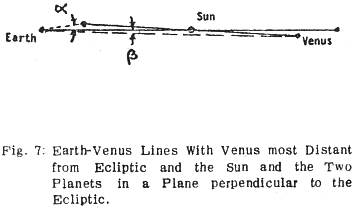
For the conditions shown in Fig. 7, the lines of sight from Earth to Venus make angles α = 8° 48′ and β = 1° 26′ respectively with the Ecliptic. The construction dates for these lines of sight to correspond with the normals to the faces of the pyramids at Dashur, taking into account the curve given in Fig. 6, are shown in Table 3. The dates again give pause, for they lie well before the accepted dates. For the student of techniques of pyramid construction we also notice an interesting result: The upper portion of the “Bent” pyramid is indicated as having been constructed several thousand years prior to the lower portion. It would seem that the problem of the choice of pyramid slope angles has still to be resolved.
| γ | |||||
| Pyramid | Slope θ |
Latitude φ |
(θ − φ) + α |
(θ − φ) − β |
Approx. Construction Date if ε = γ |
| “Bent” | 43° 21′ | 29° 41′ | 22° 28′ | 23,000 BC | |
| 54° 31′ | 23° 24′ | 16,000 BC | |||
| Northern | 43° 30′ | 29° 41′ | 22° 47′ | 18,000 BC | |
| 1. | A. Fakhry, The Pyramids, University of Chicago Press, Second Edition, 1969. |
| 2. | G. S. Pawley and N. Abrahamsen, “Do the Pyramids show Continental Drift?” Science, Vol. 179, March 1973, pp 892–893. |
| 3. | K. Mendelssohn, The Riddle of the Pyramids, Praeger Publishers, 1974. |
| 4. | J-P. Lauer, “Sur le Choix de l’angle de Pente dans les Pyramides d’Egypte”, Bulletin de l’Institut d’Egypte, XXXVII (1956), pp 57–66. |
| 5. | S. G. Sharaf and N. A. Boudnikova, “On Secular Perturbations in the Elements of the Earth’s Orbit and their Influence on the Climates in the Geologic Past”, Bulletin of the Institute of Theoretical Astronomy, Vol. 11, 1967, pp 231–248. |